新加坡海湾景观工程 / 世界上最大的景观工程之一
Garden Grant Associates place scale Singapore waterfront 场所尺度 新加坡 滨水景观 花园
Gardens by the Bay项目是新加坡最大的海滨发展景观项目,由国家支持。新加坡国家公园局和来自英国的世界级景观事务所Grant Associates通力合作完成。花园有两个大温室,一个是荫凉干爽的环境,一个是潮湿荫凉的环境,还有众多主题园,植物园,里面种植着来自世界各地的成千上万植物。这个公园中最让人印象深刻的要素是一些高25米—50米的树状结构,上面成长着垂直花园。攀缘植物,附生植物还有蕨类植物成长在上面。白天,这些结构带来荫凉,夜晚,这些结构发出光辉。一条飘逸曲折的人行桥凌空穿梭在这些结构间,给人们全新的视野,让大家可以观赏到海湾全景。

这个工程也是世界上最大的景观工程之一,101公顷的面积包含三个不同的花园:南湾,东湾,中湾。在展现最好的园艺和园林艺术同时,为本地和国际游客提供一个美好的去处,并极大的提升新加坡的国际形象。伟大的跨国合作,一个自然与科技完美结合的项目。
更多信息请参见下方英文。
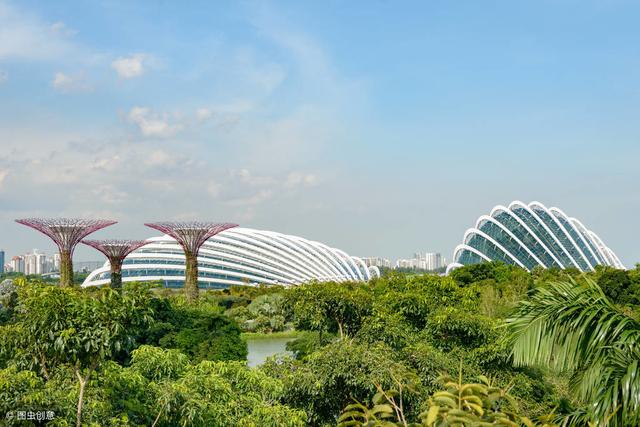
SummaryThe first phase of Singapore’s dramatic Gardens by the Bay project opens to the public on 29th June following completion of the 54-hectare £500m Bay South Garden by a world-class British design team led by Bath-based landscape architects, Grant Associates.
Details
Gardens by the Bay is one of the largest garden projects of its kind in the world. Ultimately, the site will total 101 hectares comprising three distinct gardens – Bay South, Bay East and Bay Central. Located on reclaimed land in Singapore’s new downtown at Marina Bay, the site will provide a unique leisure destination for local and international visitors.
The project is an integral part of Singapore’s “City in a Garden” vision, designed to raise the profile of the city globally whilst showcasing the best of horticulture and garden artistry.
A Great British Collaboration
Following an international design competition, a team led by landscape architecture firm Grant Associates was appointed in 2006 by the National Parks Board of Singapore to masterplan Bay South Garden, the first and largest of the three planned gardens at Gardens by the Bay.
Alongside lead designers Grant Associates, the British design team for Bay South includes Wilkinson Eyre (architects); Atelier Ten (environmental design consultants); Atelier One (structural engineers); Land Design Studio (museum and visitor center designers) and Thomas Matthews (communication designers).
A Fusion of Nature and Technology
Taking inspiration from the form of the orchid, Grant Associates’ masterplan is a rich fusion of nature, technology and environmental management. Stunning architectural structures are combined with a wide variety of horticultural displays, daily light and sound shows, lakes, forests, event spaces and a host of dining and retail offerings. The whole plan has an intelligent environmental infrastructure, allowing endangered plants, which could not normally grow in Singapore to flourish, providing both leisure and education to the nation.

海湾花园
Highlights of Gardens by the Bay are many and include:
Cooled Conservatories
Two giant biomes designed by Wilkinson Eyre Architects – the Flower Dome (1.2 hectare) and the Cloud Forest Dome (0.8 hectare) – display plants and flowers from the Mediterranean-type climatic regions and Tropical Montane (Cloud Forest) environments and provide an all-weather “edutainment” space within the Gardens.
Supertrees
Between 25 and 50 metres in height, the 18 Supertrees designed by Grant Associates are iconic vertical gardens, with emphasis placed on creating a “wow” factor through the vertical display of tropical flowering climbers, epiphytes and ferns. At night, these canopies come alive with lighting and projected media. An aerial walkway suspended from the Supertrees offers visitors a unique perspective on the gardens. The Supertrees are embedded with sustainable energy and water technologies integral to the cooling of the Cooled Conservatories.
Horticultural Gardens
Two collections The Heritage Gardens and The World of Plants centre on ‘Plants and People’ and ‘Plants and Planet’. Together with mass flowering and coloured foliage landscape, they form a spectacle of colour and texture and fragrance within the Gardens, providing a mesmerising experience for visitors.

“Our brief for Gardens by the Bay was to create the most amazing tropical gardens in the world, incorporating cutting edge environmental design and sustainable development principles. We had to factor in the challenges of both the Singaporean climate and working on a reclaimed waterfront. We wanted to capture people’s relationship with nature and use innovative technology to create rich lifestyle, educational and recreational experiences for both local residents of Singapore and visitors from around the world. All these elements informed the vision and creation of the gardens.” — Andrew Grant, Director, Grant Associates
“We were very fortunate to work with the right team to make the vision for Gardens for the Bay work. Our ethos as landscape architects is collaborative. Working with great architects, engineers and environmental specialists we created some very imaginative and innovative ideas that the National Parks Board championed. With these elements the end result at Gardens for the Bay is wonderful, impactful and powerful. It’s been a dream project to work on.” — Keith French, Project Director for Gardens by the Bay at Grant Associates
“Gardens by the Bay provides a unique green space and horticulture-themed leisure destination in the heart of the new downtown at Marina Bay, for everyone to enjoy and cherish. It has been an incredible journey for our horticultural and development staff to bring the gardens to life. We are excited to finally share the treasures of this new garden with Singapore and the rest of the world.” — Dr. Kiat W. Tan, CEO, Gardens by the Bay

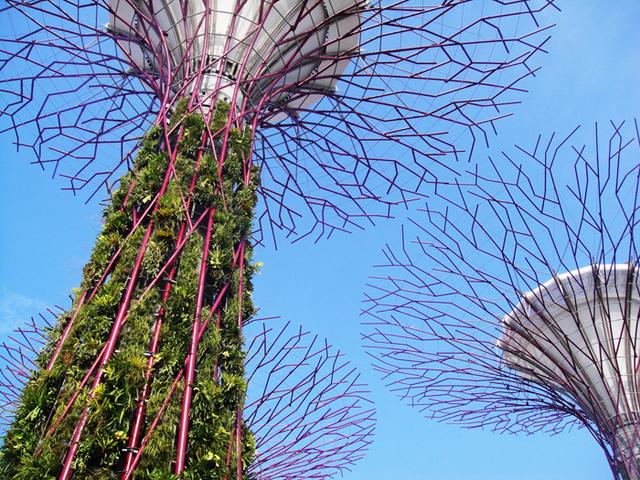



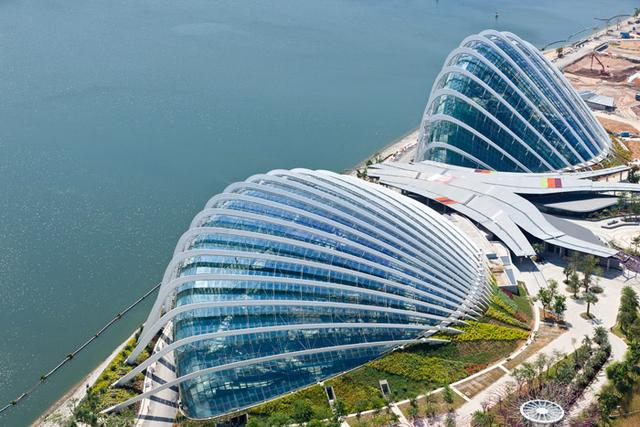













Here’s some more information from the Grant Associates:
Gardens by the Bay Fact Sheet
Bay South is the largest garden at Gardens by the Bay and it stands at 54 hectares located next to the Marina Bay Sands. Masterplanned by UK-based landscape architecture firm Grant Associates, this lively and vibrant garden showcases the best of tropical horticulture and garden artistry with a mass display of tropical flowers and colored foliage and more. Key highlights are:
Supertrees
• Designed by Grant Associates as tree-like structures between 25 metres and 50 metres in height (9 to 16 storeys), the 18 Supertrees are uniquely designed vertical gardens, with emphasis placed on creating a “wow” factor through the vertical display of tropical flowering climbers, epiphytes and ferns. At night, these canopies come alive with lighting and projected media produced by Lighting Planners Associates.
• The Supertrees are embedded with sustainable energy and water technologies integral to the cooling of the Conservatory.
• Given the equatorial climate, the grove of Supertrees will help to ameliorate discomfort by providing shade and shelter with the canopy.
• The Supertrees support a bar at the top of the tallest tree (designed by Wilkinson Eyre Architects) and an aerial walkway experience 20m above the ground (designed by Grant Associates).
Cooled Conservatories
• The Conservatory Complex is an architectural icon, a horticultural attraction and a showcase of sustainable energy technology.
• Comprising two biomes designed by Wilkinson Eyre Architects – the Flower Dome (1.2 hectare) and the Cloud Forest (0.8 hectare) – that display plants and flowers from the Mediterranean-type climatic regions and Tropical Montane (Cloud Forest) environments respectively, the Conservatory Complex will provide an all-weather “edutainment” space within the Gardens.
• The internal gardens and landscapes are designed by Grant Associates in collaboration with Wilkinson Eyre Architects.
• To ascertain the environmentally sensitive energy requirements of the Conservatory, NParks commissioned an energy modeling study. The study shows that, by applying the latest cooling technologies, the energy consumption for the Conservatory is comparable to that of an average commercial building in Singapore of the same footprint and height, normalised to a 24-hour cooling period.
Horticultural Themed Gardens
• Designed by Grant Associates with planting by NParks, these gardens showcase the best of tropical horticulture and garden artistry. Together with mass flowering and coloured foliage landscape, they form a spectacle of colour and texture and fragrance within the Gardens, providing a mesmerising experience for visitors.
• There are 2 collections, namely the Heritage Gardens and The World of Plants, which centre on the subjects: ‘Plants and People’ and ‘Plants and Planet’.
Heritage Gardens:
This is a collection of 4 gardens that reflects the history and culture of Singapore’s main ethnic groups as well as the city-state’s colonial heritage. Each Garden explores the rich cultural significance of different plant species including their symbolism, religious significance, trade, food and medicinal uses etc.
• The Malay Garden tells the story of life in a traditional “kampong” (village)
• The Indian Garden’s layout echoes a traditional illustrated flower motif.
• The Chinese Garden reflects the role of gardens in Chinese culture as places of inspiration for writers, poets and artists, through seclusion and tranquility.
• The Colonial Garden tells the story of plants as “Engines of Empire” – lucrative crops, spices and plants that formed important trade routes between the East and the West.
The World of Plants:
The second collection of gardens is based on the theme “Plants and Planet” and showcases the biodiversity of plant life on our planet. There are 6 gardens in total:
• Secret Life of Trees examines trees, what they are, their functions and their evolution. It also investigates the role of trees in the rainforest.
• World of Palms celebrates the rich diversity of the world of tropical palms and their particular ecological niches. Different shapes of fronds and seeds, as well as the versatile use of palms are also highlighted in the garden.
• Understorey features the forest root zone & plant species of the forest floor. Stories include how plants have adapted to the specific environments such as low light levels and poor soil as well as the cycle of decomposition.
• Fruits and Flowers is about the amazing world of flowers and fruits. There are stories about the form and function of flowers and fruits, why plants need flowers and fruits and the domestication of rainforest fruits.
• Discovery Garden looks at plant evolution throughout the lifespan of the planet, and focuses on selected ancient groups of plants. By providing visitors with a glimpse of the long time it took for the plant diversity we see today to evolve, it also draws a comparison with the accelerated rate of extinction caused by man.
• Web of Life focuses on the interrelationship of rainforest flora with fauna. The main subject will be the web of life. This will include the keystone species and food chains in the tropical rainforest. The focus will be on the fig as keystone species.
Other Bay South Garden Attractions
In addition to this collection of special gardens, the site includes a wide range of additional Garden attractions. These include:
• Supertree Grove is the largest garden at the heart of the site featuring a cluster of 12 Supertrees. The garden is lined by a 300m long colonnaded walkway providing shaded and dry connection across the site and by a display of Aerial Root pergolas displaying tropical climbing plants.
• Dragonfly Lake is a 1km long lake creating a dramatic setting to the Supertrees and Conservatories. The distinctive Dragonfly Bridge connects the city to the central gardens. The lake is lined by boardwalk and special aquatic gardens and a system of filter beds that are part of the water quality management for the site.
• Marina promenade is a 1km tree lined walkway along the Marina edge linking the city centre with the Barrage
• Tadpole Play Area is a nature themed playground set within a planted rainforest
• Fragile Forest has been planted using native species to simulate a typical S.E.Asian Rainforest
• Events Lawn is a large open space capable of holding outdoor concerts and events for 10,000 people or more
Supertrees Fact Sheet
Concept
• Designed by Grant Associates the Supertrees are unique vertical gardens ranging from 25 to 50 metres in height (equivalent to 9 to 16 storeys), with emphasis placed on the vertical display of tropical flowering climbers, epiphytes and ferns.
• There are a total of 18 Supertrees, all located within Bay South at Gardens by the Bay. Out of the 18 Supertrees, 12 are situated in the Supertree Grove while the remaining 6 are placed in clusters of threes near the Arrival Square and Dragonfly Lake.
• Given the relatively short time span to create a garden from reclaimed land, the Supertrees provide an immediate scale and dimension to the Gardens while marrying the form and function of mature trees. They also create height to balance the current and future tall developments in the Marina Bay area.
• In the day the Supertrees’ large canopies provide shade and shelter. At night, the Supertrees come alive with lighting and projected media created by Lighting Planners Associates.
• A 128-metre-long aerial walkway designed by Grant Associates connects the two 42-metre Supertrees in the Supertree Grove to enable visitors to take in a different
view of the Gardens from a height of 22 metres.
• The 50-metre Supertree has a treetop bistro designed by Wilkinson Eyre offering a panoramic view of the Gardens and surrounding Marina Bay area.
Construction
The Supertree comprises 4 major parts created by structural engineers Atelier One:
• Reinforcement concrete core – Inner vertical structure that upholds the Supertree
• Trunk – A steel frame attached around the reinforcement concrete core
• Planting panels – Installed on the trunk in preparation for the planting of the living skin
• Canopy – Shaped like an inverted umbrella, the canopy was assembled and hoisted via a hydraulic jack system (with the exception of the 50m Supertree canopy assembled at its final height).
Environmentally Sustainable Functions
• The Supertrees were planned from the outset to showcase innovative environmental technologies and to become an integral part of the overall site environmental systems. In addition to the creation of habitat and shaded spaces through the use of vertical planting, some will have photovoltaic cells to harvest solar energy, others include rainwater harvesting and some will be integrated with the Cooled Conservatories and energy centre to serve as air exhausts.
Plants
• Over 162,900 plants comprising more than 200 species and varieties of bromeliads, orchids, ferns and tropical flowering climbers will be planted on the 18 Supertrees.
• Examples of some of the species that will be planted on the Supertrees include the Tillandsia stricta from Brazil, Tillandsia fasciculate from Panama, Cattleya maxima from Ecuador, and Pseudorhipsalis from Costa Rica.
• The plants are chosen based on the following considerations:
o Suitability for vertical planting
o Lightweight and hardy
o Soil-less
o Easy to maintain
o Suitable for Singapore’s tropical climate
o Not commonly found in Singapore
o Visually interesting
• The Supertrees have different planting schemes in various colours ranging from
warm tones like reds, browns, orange and yellows, to cooler hues like silver and pink.
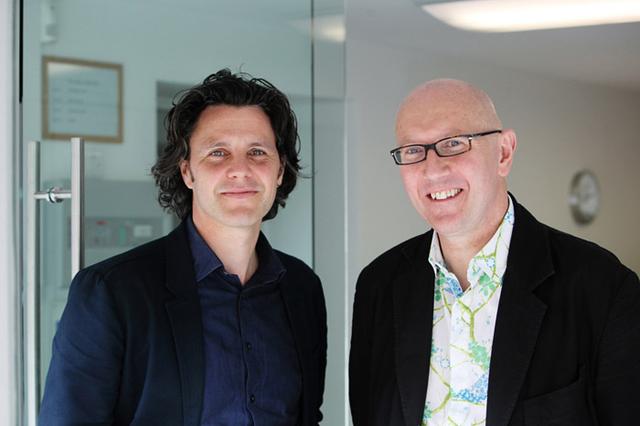
MORE:






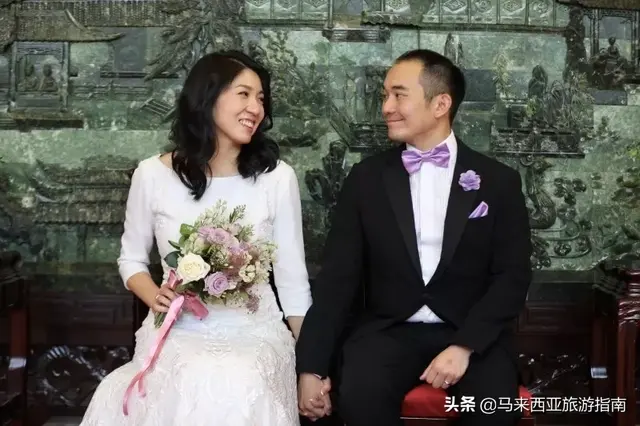
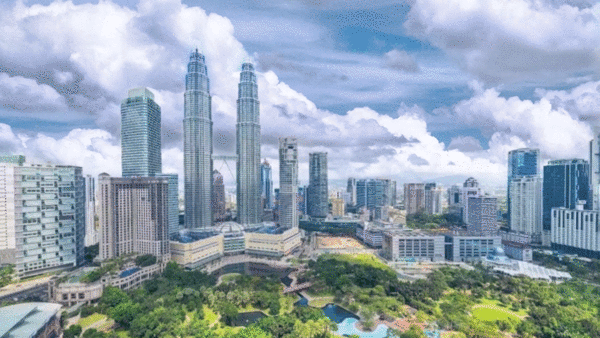
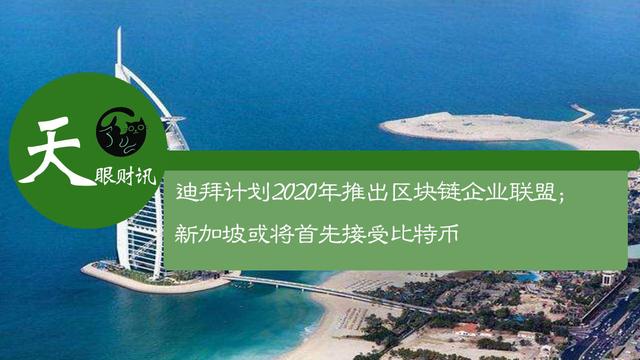
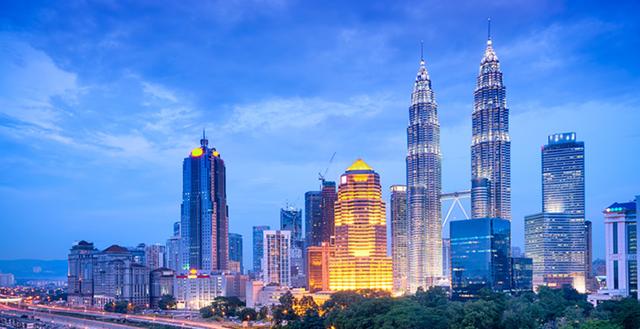
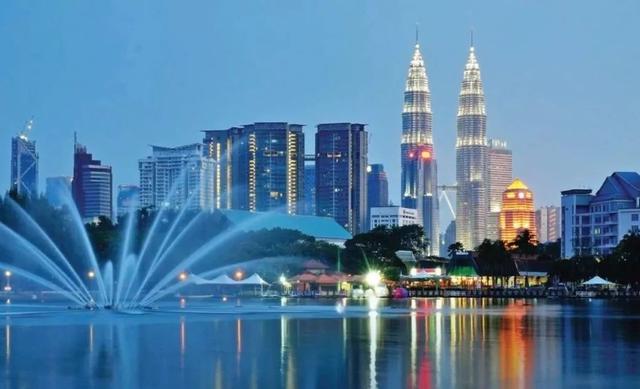











评论